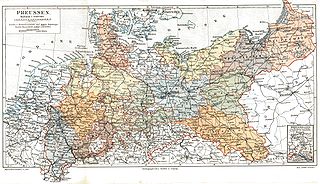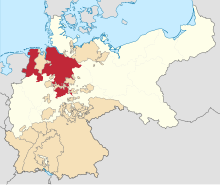
Lower Saxony is a German state (Land) situated in northwestern Germany. It is the second-largest state by land area, with 47,624 km2 (18,388 sq mi), and fourth-largest in population among the 16 Länder federated as the Federal Republic of Germany. In rural areas, Northern Low Saxon and Saterland Frisian are still spoken, in declining numbers.

A Regierungsbezirk means "governmental district" and is a type of administrative division in Germany. Four of sixteen Bundesländer are split into Regierungsbezirke. Beneath these are rural and urban districts.

Harburg is a district (Landkreis) in Lower Saxony, Germany. It takes its name from the town of Harburg upon Elbe, which used to be the capital of the district but is now part of Hamburg. It is bounded by the districts of Lüneburg, Heidekreis, Rotenburg (Wümme) and Stade, by the City of Hamburg and the State of Schleswig-Holstein.
Diepholz is a district in Lower Saxony, Germany. It is bounded by the districts of Verden, Nienburg, Minden-Lübbecke, Osnabrück, Vechta and Oldenburg, and by the cities of Delmenhorst and Bremen. The most populous municipality is Stuhr at the border to Bremen.

Lüneburg was one of the four Regierungsbezirke of Lower Saxony, Germany, located in the north of the federal state between the three cities Bremen, Hamburg and Hanover.
Hanover is a territory that was at various times a principality within the Holy Roman Empire, an Electorate within the same, an independent Kingdom, and a subordinate Province within the Kingdom of Prussia. The territory was named after its capital, the city of Hanover, which was the principal town of the region from 1636. In contemporary usage, the name is only used for the city; most of the historical territory of Hanover forms the greater part of the German Land of Lower Saxony but excludes certain areas.

The Provinces of Prussia were the main administrative divisions of Prussia from 1815 to 1946. Prussia's province system was introduced in the Stein-Hardenberg Reforms in 1815, and were mostly organized from duchies and historical regions. Provinces were divided into several Regierungsbezirke, sub-divided into Kreise (districts), and then into Gemeinden (townships) at the lowest level. Provinces constituted the highest level of administration in the Kingdom of Prussia and Free State of Prussia until 1933, when Nazi Germany established de facto direct rule over provincial politics, and were formally abolished in 1946 following World War II. The Prussian provinces became the basis for many federal states of Germany, and the states of Brandenburg, Lower Saxony, and Schleswig-Holstein are direct successors of provinces.

The Kingdom of Hanover was established in October 1814 by the Congress of Vienna, with the restoration of George III to his Hanoverian territories after the Napoleonic era. It succeeded the former Electorate of Hanover, and joined 38 other sovereign states in the German Confederation in June 1815. The kingdom was ruled by the House of Hanover, a cadet branch of the House of Welf, in personal union with the United Kingdom of Great Britain and Ireland since 1714. Since its monarch resided in London, a viceroy, usually a younger member of the British Royal Family, handled the administration of the Kingdom of Hanover.

The County of Hoya was a state of the Holy Roman Empire, located in the present German state of Lower Saxony. It was centered on the town of Hoya on the middle Weser river, between Bremen and Nienburg; the area now belongs to the districts of Nienburg and Diepholz. The largest city of the county was Nienburg.

The Diocese of Osnabrück is a Latin Church ecclesiastical territory or diocese of the Catholic church in Germany. The diocese was originally founded circa 800. It should not be confused with the smaller Prince-Bishopric of Osnabrück–an ecclesiastical principality of the Holy Roman Empire until 1803–over which the bishop, as prince-bishop, exercised both temporal and spiritual authority.

The Electorate of Hanover was an Electorate of the Holy Roman Empire, located in northwestern Germany and taking its name from the capital city of Hanover. It was formally known as the Electorate of Brunswick-Lüneburg. For most of its existence, the electorate was ruled in personal union with Great Britain and Ireland following the Hanoverian Succession.

Bremen Hauptbahnhof is a railway station in the city of Bremen in northwestern Germany. It is the most important rail station for both the city and state of Bremen; InterCityExpress, Intercity, EuroCity, CityNightLine and DB NachtZug services call at the station, which is situated to the Northeast of the city centre. The train services are operated by Deutsche Bahn, NordWestBahn, Metronom and Erixx.

The Bremen–Bremerhaven railway line is a railway line connecting the German cities Bremen and Bremerhaven. It is an entirely two-track and electrified mainline railway that is operated Deutsche Bahn. It is designed for speeds of up to 160 km/h. In section from Bremen Hauptbahnhof to Bremerhaven Hauptbahnhof is 62.0 km long, but its extension via Bremerhaven-Lehe to the Bremerhaven-Speckenbüttel marshalling yard and on to Columbuskaje is also often included. The most important intermediate station is Osterholz-Scharmbeck, where Regional-Express trains also stop.
The Royal Hanoverian State Railways existed from 1843 until the annexation of the Kingdom of Hanover by the Kingdom of Prussia in 1866. At that time its railway network, which comprised 800 kilometres of track, went over to the Prussian state.
The Stade Region emerged in 1823 by an administrative reorganisation of the dominions of the Kingdom of Hanover, a sovereign state, whose then territory is almost completely part of today's German federal state of Lower Saxony. Until 1837 the Kingdom of Hanover was ruled in personal union by the Kings of the United Kingdom of Great Britain and Ireland.

The Lower Saxon Mill Road is a holiday route that guides visitors to watermills and windmills in the north German state of Lower Saxony and thus links the interests of historic monument conservation with those of the tourist industry.
The Wesermünde Geest is the collective name for several geest ridges in the west of Cuxhaven district and Bremen's North Borough in northern Germany. The ridges are separated from one another by wetlands. These terminal moraines were formed during the Saale glaciation, are up to between 10 to 70 m above sea level (NN), and are covered by scattered woods and farmland. The wetland areas, between 0 to 5 m above sea level, are predominantly used for grazing.
The County of Diepholz, that was first known as the Lordship of Diepholz, was a territory in the Holy Roman Empire in the Lower-Rhenish-Westphalian Circle. It was ruled by the Noble Lords, later Counts, of Diepholz from the late tenth century until 1585, when it was mostly incorporated into the Duchy of Brunswick-Lüneburg.



















